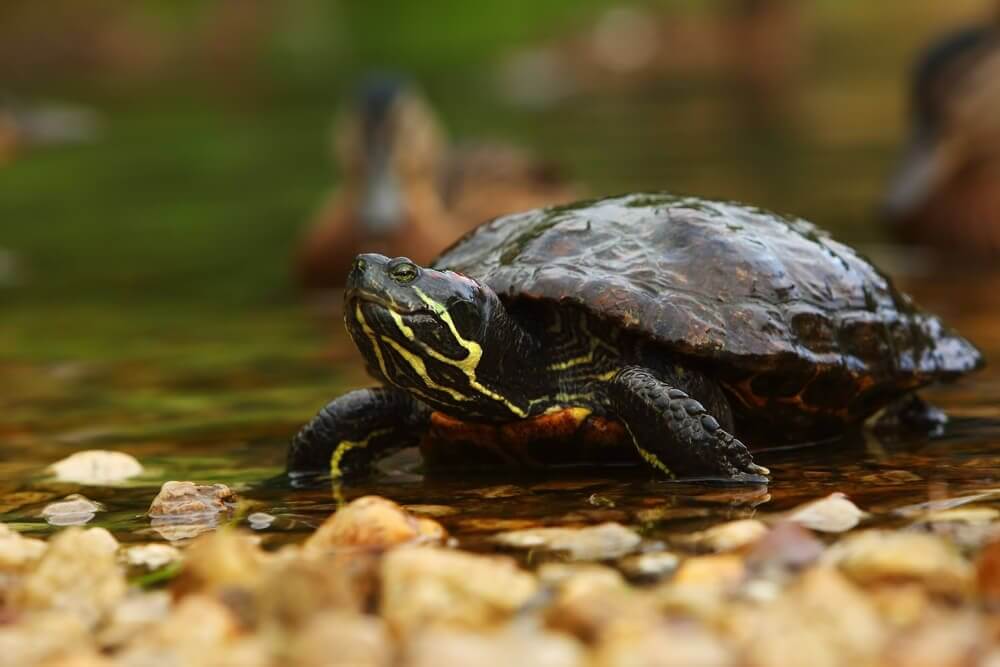Turtles are interesting animals that have been around for a long period of time. Many people wonder if turtles have teeth, and the answer is yes, but their teeth are not like those of other animals. Turtles have a beak-like structure made of keratin, the same material as our fingernails and hair.
This beak allows them to grip and crush their food, which is mostly plants, insects, and small animals. Some species of turtles, like the leatherback sea turtle, don’t have teeth at all, as they have evolved to swallow their prey whole. So while turtles don’t have traditional teeth, they have adapted to have a unique beak that helps them survive and thrive in their environments.
Anatomy of a Turtle’s Mouth.
A turtle’s mouth is a unique feature that has evolved over millions of years to suit its specific needs. The mouth of a turtle is made up of two main parts, the beak, and the jaw. The beak is a hard, keratinized structure that covers the turtle’s upper and lower jaw. The shape and size of the beak vary depending on the species of turtle and its diet.

Some turtles have a sharp, pointed beak, while others have a broad, flat beak. The jaw of a turtle is also unique in that it is not fused to the skull, allowing the turtle to move its jaw independently. This adaptation is helpful when feeding on different types of prey, as the turtle can adjust the angle and position of its jaw to better grasp and manipulate its food.
Different parts of the mouth, such as the beak, tongue, and jaw muscles.
Here we will explore the different parts of the mouth, such as the beak, tongue, and jaw muscles, and how they contribute to overall oral health and function.
-
The Beak
The beak, also known as the mouth roof or palate, is the hard and bony structure that forms the roof of the mouth. The beak plays a critical role in the process of chewing and swallowing food. It also helps to create a seal between the mouth and the nasal cavity, preventing food and liquids from entering the nose. The beak is divided into two parts, the hard palate located in the front and the soft palate located at the back. The hard palate is responsible for breaking down food, while the soft palate helps to control the flow of air and food through the mouth.
-
The Tongue
The tongue is a muscular organ that is responsible for a wide range of functions, including taste, speech, and swallowing. It is made up of several muscles that work together to move food around the mouth and push it toward the throat. The tongue is also responsible for detecting different tastes, such as sweet, sour, salty, and bitter, and relaying this information to the brain. Additionally, the tongue plays a critical role in speech production, helping to articulate different sounds and words.
-
The Jaw Muscles
The jaw muscles are a group of muscles that are responsible for moving the jaw and allowing us to chew, speak, and yawn. The jaw muscles are among the strongest muscles in the human body and are capable of generating a tremendous amount of force. These muscles are divided into two groups, the temporalis muscles located at the temples and the masseter muscles located at the back of the jaw. The temporalis muscles are responsible for closing the jaw, while the masseter muscles are responsible for opening and closing the jaw.
Different species of turtles and their dental characteristics.
Turtles are fascinating creatures, with their unique shells and slow, deliberate movements. But did you know that they also have interesting dental characteristics? Here we will take a closer look at different species of turtles and their teeth.
Now, let’s take a look at some different species of turtles and their dental characteristics.
-
Snapping Turtles
Snapping turtles are known for their powerful jaws and sharp beaks. They have a row of tomial teeth in their throats, which they use to crush the shells of their prey. Snapping turtles have a unique dental adaptation called “pseudopodia,” which means that their tomial teeth are shaped like a saw blade. This allows them to easily break through tough shells and even bones.
-
Box Turtles
Box turtles have a beak that is shaped like a parrot’s beak. They have a single row of tomial teeth in their throats, which they use to crush and grind their food. Box turtles have a unique dental adaptation called “zygomatic arch tooth,” which is a tooth that is located on the cheekbone. This tooth is used to help break down tough vegetation.

-
Sea Turtles
Sea turtles have a smooth, flat beak that is used to bite and tear their food. They have no tomial teeth, but instead, have a series of serrated edges in their jaws that help them to grip and tear their food. Sea turtles have a unique dental adaptation called “papillae,” which are small, fleshy bumps on their tongues. These papillae help the turtle to grip and swallow their food.
-
Tortoises
Tortoises have a beak that is shaped like a rhinoceros horn. They have a single row of tomial teeth in their throats, which they use to crush and grind their food. Tortoises have a unique dental adaptation called “enameloid,” which is a layer of enamel that covers their beak. This enamel helps to protect their beak from wear and tear.
Discuss the function of teeth in turtles, if they have them.
Here we will explore the function of teeth in turtles and whether all turtles have them. Do Turtles Have Teeth?
Yes, turtles do have teeth. However, the number and type of teeth vary depending on the species. Some turtles have sharp, pointed teeth that are used for crushing and cutting food, while others have serrated teeth that are used for gripping and tearing.
The Function of Teeth in Turtles
-
Capturing Prey
Turtles are known for their omnivorous diets, which means they eat both plants and animals. Aquatic turtles, such as the snapping turtle, have sharp teeth that are perfect for capturing prey. These teeth are used to grasp and hold onto their food before they swallow it whole. The jagged, sharp teeth in their mouths make it easier for them to hang onto their food and prevent it from escaping.
-
Crushing and Grinding
Turtles that feed on tough vegetation need teeth that can grind and crush their food. These teeth are flat, broad, and strong enough to break down their food into smaller pieces. Tortoises, for example, have wide, flat teeth that are perfect for grinding down tough grasses and plants.
-
Defense Mechanism
For some turtles, teeth serve as a defense mechanism. Some species have sharp, pointed teeth that can inflict serious damage on predators or other turtles. For example, the alligator snapping turtle has sharp, powerful jaws that are capable of crushing bones and causing serious injury.
-
Attracting Mates
Some turtles have specialized teeth that are used for attracting mates. For example, male box turtles have bright, colorful mouths with yellow or orange markings. These markings are thought to attract female turtles during the breeding season.
Do turtles lose their teeth?
Yes, turtles do lose their teeth, but they have a unique way of replacing them. Unlike humans, turtles have continuously growing teeth throughout their lives.

As their old teeth wear down or fall out, new ones grow in to replace them. This process of tooth replacement in turtles is known as polyphyodonty. Depending on the species, turtles can have up to 60 or more teeth in their mouths at any given time. So, while they do lose and replace their teeth, they don’t have to worry about running out of them as humans do.
Do turtles have fangs?
Turtles do not have fangs. Turtles are known for their hard shells and beaked mouths, which are designed for grinding and crushing their food. They have a set of sharp, pointed jaw edges that enable them to bite and hold onto their prey, but these are not considered fangs. While some species of turtles have a more carnivorous diet than others, they do not have the specialized teeth or fangs that are typically associated with meat-eating animals. Instead, turtles rely on their powerful jaws and sharp edges to capture and consume their prey.
Conclusion.
In conclusion, do turtles have teeth? The answer is yes, but not in the way that we typically think of teeth. Turtles have a range of structures that allow them to break down and digest food, from sharp ridges to keratinous beaks to gastroliths. So the next time someone asks you if turtles have teeth. You can confidently answer that they do – just not in the way you might expect.

